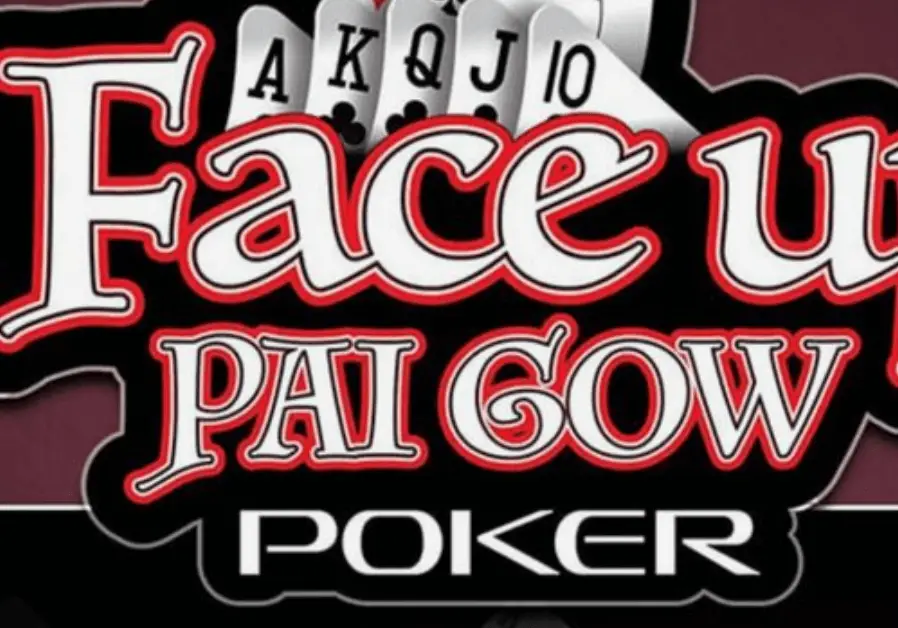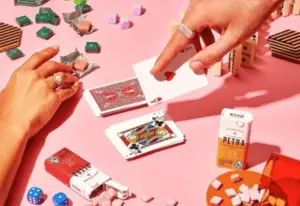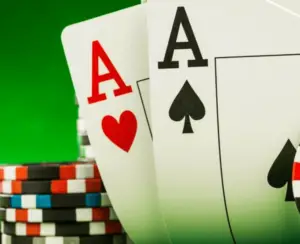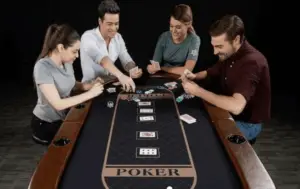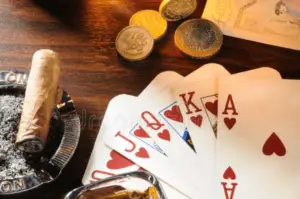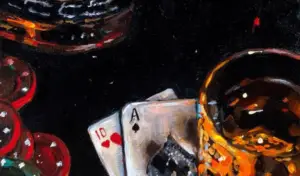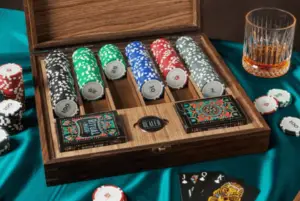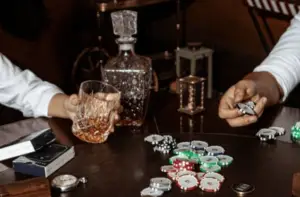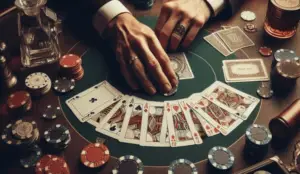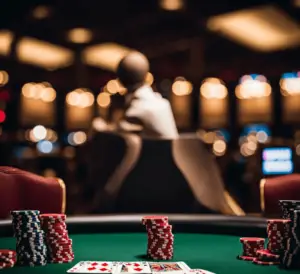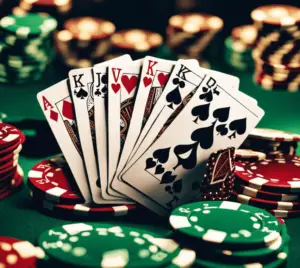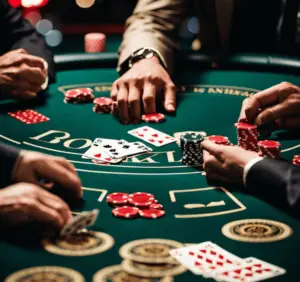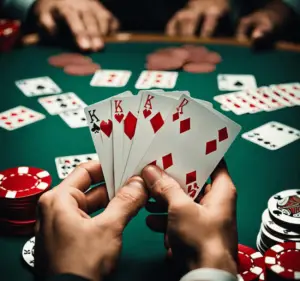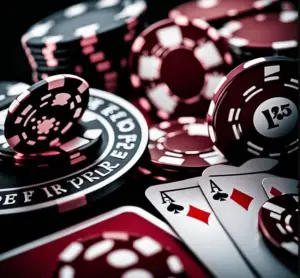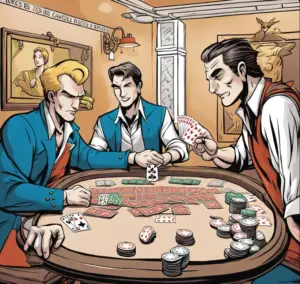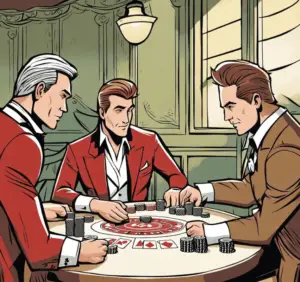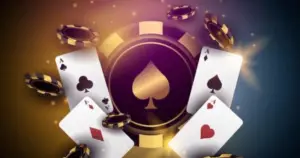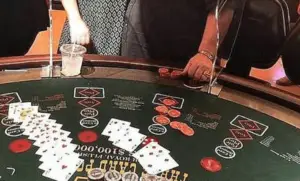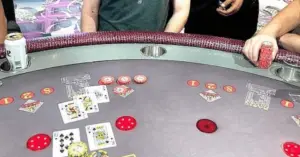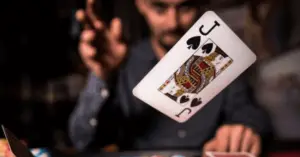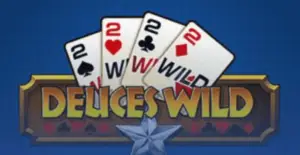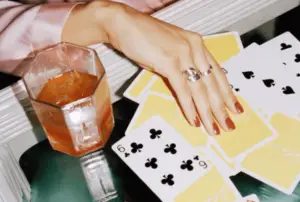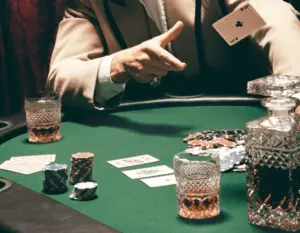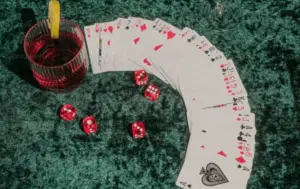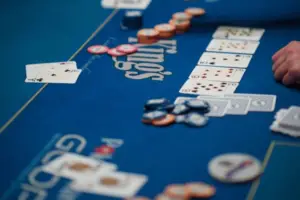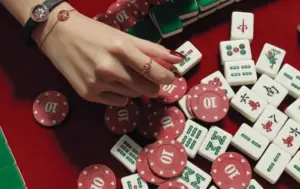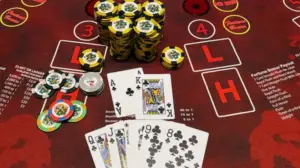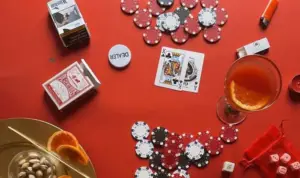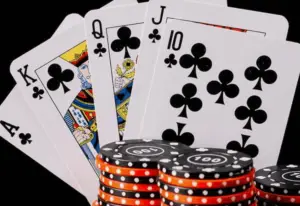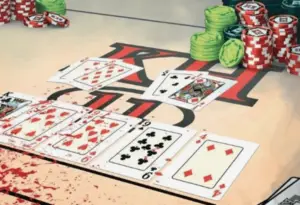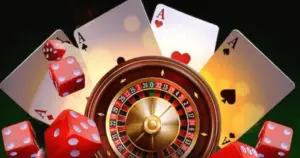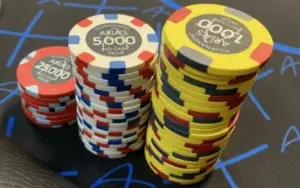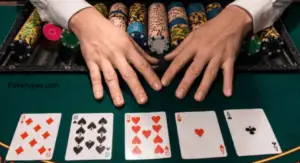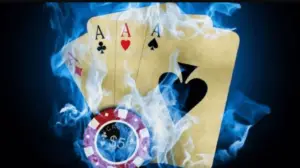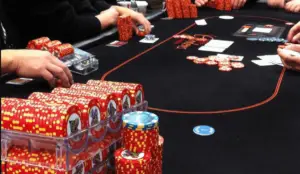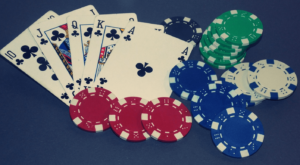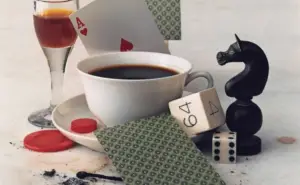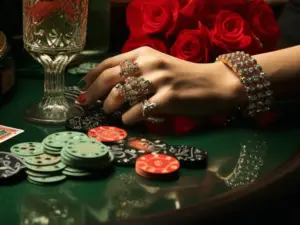Face Up Pai Gow Poker is a fun twist on the classic casino game. It’s like regular Pai Gow Poker but with a big difference – the dealer’s hand is shown face-up! This gives players a cool advantage.
The game uses a 53-card deck (52 regular cards plus a joker). Players and the dealer get seven cards each to make two hands – a five-card high hand and a two-card low hand.
The Joker is semi-wild, meaning it can be an ace or help complete certain hands. One key change is that if the dealer’s best hand is just ace-high, it’s an automatic push – nobody wins or loses.
To spice things up, there’s often a side bet called “Push Ace High” that pays out if this happens. With no 5% commission on wins and the dealer’s cards visible, Face Up Pai Gow Poker offers a fresh take on a casino classic.
Game Setup and Rules of Face Up Pai Gow Poker
Deck Composition
The game uses a 53-card deck. That’s a regular 52-card deck plus one joker. This extra card adds a fun twist to the game.
Dealing Process
Here’s how the cards are dealt:
Players make their bets.
The dealer gives out seven cards to each player and themselves.
The dealer’s cards are placed face-up on the table. This is different from regular Pai Gow Poker and gives players an edge.
Hand Formation
After getting your cards, you need to make two hands:
A five-card high hand (also called the “bottom” hand)
A two-card low hand (also called the “top” hand)
The trick is, that your high hand must be stronger than your low hand. If you mess this up, you’ll lose your bet.
For example, if you have a pair of kings and a pair of twos, you’d put the kings in your high hand and the twos in your low hand.
Joker Usage Rules
The Joker in this game is like a wild card, but with some rules:
It can be used as any card to complete a straight, flush, or straight flush.
If it’s not used for those hands, it can only be an ace.
For instance, if you have 9♠, 10♠, J♠, Q♠, and the joker, you can use the joker as a K♠ to make a royal flush.
Special Rules
Face Up Pai Gow Poker has some cool twists:
No commission: Unlike regular Pai Gow, you don’t pay a 5% fee when you win.
Ace-High Push: If the dealer’s best hand is just ace-high, it’s an automatic tie. Nobody wins or loses.
House Way: If you’re not sure how to set your hand, the dealer can help you by setting it the “House Way”.
Gameplay Mechanics of Face Up Pai Gow Poker
Below is a simple guide on how to play Face Up Pai Gow Poker in a nutshell:
Place your bet and optional side bets.
The dealer gives you and themselves seven cards each.
The dealer’s cards are face up – that’s the twist!
Split your cards into a five-card high hand and a two-card low hand.
Your high hand must beat your low hand.
If the dealer has an Ace-high Pai Gow, it’s an automatic push.
Compare your hands to the dealer’s.
Win both to get paid even money.
No commission on wins!
Now, we are going to discuss the gameplay mechanics of Face Up Pai Gow Poker in greater detail.
Dealer’s Hand Exposed Face-up
In Face Up Pai Gow Poker, the dealer’s hand is dealt face-up. This is a big change from regular Pai Gow Poker. It gives players a cool advantage because they can see what they’re up against.
The dealer sets their hand first, following strict “house way” rules. This means players can make smarter choices when setting their own hands.
Player Hand-setting Strategies
Players get seven cards and need to make two hands:
- A five-card high hand
- A two-card low hand
The trick is, that your high hand must be stronger than your low hand. If you mess this up, you lose. Here are some tips:
With no pair, use your second and third highest cards for the low hand.
If you have one pair, always put it in the high hand.
For two pairs, it gets tricky. Low pairs (2’s to 6’s) usually split unless you have an Ace or King.
With three pairs, put the highest pair in the low hand.
If you’re not sure, you can ask the dealer to set your hand the“house way”.It’s like getting a hint from the house!
Hand Ranking and Comparison
Hands are ranked just like in regular poker. Here’s a quick list from best to worst:
- Five Aces (four Aces plus the Joker)
- Royal Flush
- Straight Flush
- Four of a Kind
- Full House
- Flush
- Straight
- Three of a Kind
- Two Pair
- One Pair
- High Card
Remember, your five-card hand must always be stronger than your two-card hand.
Winning Conditions and Payouts
To win, both your hands need to beat the dealer’s hands. Here’s how it shakes out:
If you win both hands, you win even money on your bet.
If you lose both hands, you lose your bet.
If you win one hand and lose the other, it’s a tie. Your bet stays on the table.
If one of your hands is exactly the same as the dealer’s (a “copy”), the dealer wins that hand.
The cool thing about Face Up Pai Gow Poker is there’s no commission on wins. In regular Pai Gow, you’d pay a 5% fee when you win. Not here!
Automatic Push on Dealer’s Ace-high Pai Gow
Here’s where things get really interesting. If the dealer’s best five-card hand is just Ace-high, it’s an automatic push. This means:
- Nobody wins or loses
- All bets stay on the table
- It doesn’t matter what cards you have
This rule balances out the advantage players get from seeing the dealer’s hand. It happens about 9.36% of the time. But wait, there’s more!
Many casinos offer a special bet called the“Ace High Bonus”. It pays out when the dealer gets an Ace-high Pai Gow. Here’s an example of how it might pay:
If both you and the dealer have Ace-high hands: 40 to 1
If the dealer has Ace-high with a Joker: 15 to 1
If the dealer has Ace-high without a Joker: 5 to 1
This side bet adds some extra excitement to the game. But remember, like all side bets, it has a higher house edge.
Bonus Bets
Many Face-Up Pai Gow Poker tables also offer a“Fortune Bonus” bet. This pays out for strong hands, no matter what the dealer has. For example:
A seven-card straight flush (no Joker) might pay 5,000 to 1
Five Aces might pay 400 to 1
A Royal Flush might pay 150 to 1
If you bet at least $5 on the Fortune Bonus, you also qualify for“Envy Bonuses”. These pay out if anyone at the table gets a super strong hand.
House Edge
The house edge in Face Up Pai Gow Poker is about 1.80%. That’s pretty good for a casino game! It’s lower than regular Pai Gow Poker because there’s no commission on wins.
Remember, the exact edge can change based on how the dealer sets their hand. Different casinos might have slightly different rules for this.
Face Up Pai Gow Poker is a fun twist on a classic game. You get to see the dealer’s hand, there’s no commission on wins, and you might hit a big bonus payout. Just remember to set your hands carefully and have fun!
Special Features of Face Up Pai Gow Poker
Face Up Pai Gow Poker has some cool extras that make it stand out from regular Pai Gow. Let’s check them out!
1. Commission-free Gameplay
Unlike regular Pai Gow, you don’t have to pay a 5% fee when you win. That’s right, no commission! But there’s a catch – if the dealer gets an Ace-High Pai Gow, it’s an automatic tie. This happens about 9% of the time, so it balances things out.
2. Fortune Bonus Side Bet
This is where things get exciting! You can make an extra bet called the Fortune Bonus. It pays out if your seven cards make a good poker hand.
3. Qualifying Hands and Payouts
Here’s what you might win:
Seven-Card Straight Flush (no Joker): 8,000 to 1
Royal Flush plus Royal Match: 2,000 to 1
Five Aces: 400 to 1
Royal Flush: 150 to 1
Straight Flush: 50 to 1
Four-of-a-Kind: 25 to 1
There are more payouts for lower hands too. The exact odds might change depending on where you play.
3. Envy Bonus Feature
If you bet at least $5 on the Fortune Bonus, you get an “envy” button. This means you can win extra if someone else at the table gets a super good hand.
For example, if another player gets a Seven-Card Straight Flush, you might win $5,000 just for having the envy button!
4. Ace High Bonus Wager
This is another side bet you can make. It pays out if the dealer gets an Ace-High Pai Gow. The payouts might look like this:
- Dealer and Player Ace-High: 40 to 1
- Dealer Ace-High with Joker: 15 to 1
- Dealer Ace-High without Joker: 5 to 1
5. Progressive Jackpot Option
Some casinos offer a progressive jackpot on Face Up Pai Gow Poker. This is usually a $1 bet that gives you a shot at a big prize pool. The jackpot keeps growing until someone wins it. For example, at one casino, the jackpot got up to $3.5 million! The payouts might look like this:
- Seven-Card Straight Flush: 100% of the jackpot
- Royal Flush plus Royal Match: 50% of the jackpot
- Five Aces: $2,500
- Royal Flush: $200
Remember, these side bets are fun, but they usually have a higher house edge than the main game.
House Way Rules in Face Up Pai Gow Poker
In Face Up Pai Gow Poker, the House Way rules are super important. They’re like a cheat sheet for setting your hands right.
The dealer must follow these rules when setting their hand, and you can ask them to set your hand this way too. It’s a smart move if you’re not sure what to do.
For example, with no pair, you put the second and third highest cards in front. With one pair, the pair goes in back, and the highest two other cards go in front.
It gets trickier with two pairs – you might split them or keep them together, depending on what other cards you have.
If you’ve got three-of-a-kind, you usually put it in the backhand, except with Aces. The House Way also covers how to play straights, flushes, and full houses. These rules help keep the game fair and give you a better shot at winning.
Strategic Considerations in Face Up Pai Gow Poker
1. Optimal Hand-setting Based on Dealer’s Exposed Hand
In Face Up Pai Gow Poker, you get to see the dealer’s cards before setting your hand. This is a big advantage! You can use this info to make smart choices. For example, if the dealer has a weak hand, you might play it safe.
But if they have a strong hand, you might need to take more risks. Let’s say the dealer has an A-K in front and a pair of 10s in the back. You have Q-J and two pairs, 8s and 6s.
Normally, you’d split the pairs. But here, you might keep them together in the back to try for a push instead of losing both hands.
When to Split Pairs or Keep Them Together
Splitting pairs is tricky. Here’s a good rule of thumb:
With high pairs (10s or better), usually split them.
With medium pairs (7s to 9s), it depends on the dealer’s hand.
With low pairs (6s or lower), often keep them together.
For example, if you have A-A-K-K-Q-7-3 and the dealer has a strong hand, you might split the Aces and Kings. But if the dealer’s hand is weak, you could keep the Aces together for a better chance at winning both hands.
3. Handling Straights, Flushes, and Full Houses
Straights, flushes, and full houses are strong hands, but sometimes you need to break them up. Here’s how:
- With a straight or flush, if you have a pair too, often split them.
- For a full house, usually put the three-of-a-kind in the back and the pair in front.
Let’s say you have9♠-8♠-7♠-6♠-5♠-A♥-K♥. If the dealer has a strong hand, you might play the flush in the back and A-K in front. But if the dealer is weak, you could split it up to try to win both hands.
4. Importance of Pushing Instead of Losing
In Face Up Pai Gow, pushing is better than losing. Remember, you need to win both hands to win your bet. If you win one and lose one, it’s a push. So sometimes, it’s smart to aim for a push when you can’t win.
For instance, if you have Q-Q-J-10-9-8-7 and the dealer has A-A in front, and K-K-K-2-2 in back, you can’t win both hands.
But you can push by playing Q-Q-J-10-9 in the back and 8-7 in front. You’ll lose the front hand but might win the back, resulting in a push.
Bonus Tip: Using the House Way
If you’re not sure how to set your hand, you can ask the dealer to set it the“House Way”. This is a set of rules the dealer uses to set their own hand. It’s not always the best play, but it’s a good starting point.
Remember, in Face Up Pai Gow Poker, about 50% of hands end in a push. This makes the game last longer and gives you more chances to hit a bonus bet if you’re playing those.
Advantages and Disadvantages of Face Up Pai Gow Poker
| Aspect | Face Up Pai Gow Poker | Face-down Pai Gow Poker |
| Dealer’s Hand | Visible before setting | Hidden until end |
| Strategy | Can adjust based on dealer’s hand | Less strategic options |
| House Edge | About 1.81% | About 2.84% |
| Commission | No commission on wins | 5% commission on wins |
| Ace-High Rule | Automatic push if the dealer has Ace-High | No special Ace-High rule |
| Gameplay Speed | Slightly slower due to strategy | Faster rounds |
| Bonus Bets | Fortune Bonus and Ace-High Bonus available | Typically only Fortune Bonus |
| Player Advantage | Can make smarter decisions | More guesswork involved |
| Push Frequency | Higher (about 50% of hands) | Lower push rate |
| Skill Factor | Higher skill ceiling | Less skill-dependent |
Tips for New Players
If you’re new to Face Up Pai Gow Poker, here are some tips to help you out. First, avoid common mistakes like setting your low hand stronger than your high hand – that’s a big no-no and will cost you your bet.
Always be polite at the table and follow the dealer’s instructions. It’s cool to ask for help if you’re not sure how to set your hand. When it comes to money, be smart. Set a budget before you play and stick to it.
Don’t chase losses by betting more than you planned. Remember, this game has a lot of pushes, so your money can last longer than in other games.
It’s okay to take breaks and walk away if you’re not having fun. Lastly, don’t forget to tip your dealer if you win big – it’s good karma!
Conclusion
Face Up Pai Gow Poker is a cool twist on the classic game that’s gaining fans fast. With a lower house edge of just 1.81% and no commission on wins, it’s a smart bet.
The key to success is using the dealer’s exposed hand to make smart choices when setting your own.
Remember to split high pairs, keep low pairs together, and aim for a push when you can’t win. Don’t forget to try the Fortune Bonus for a shot at big payouts.
With lots of pushes, your money can last longer, making it perfect for a fun night at the casino. Just play smart and enjoy the ride!
